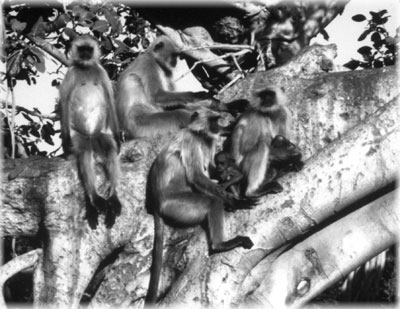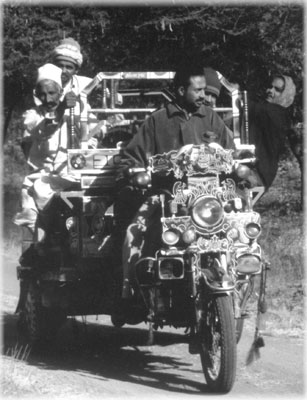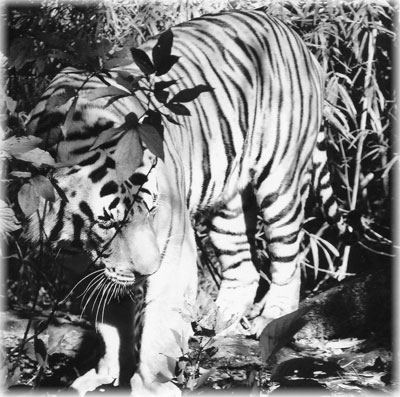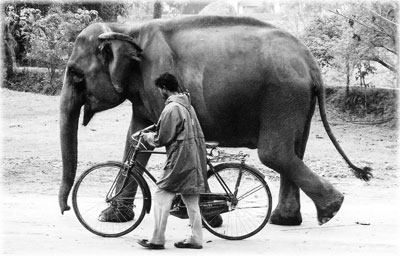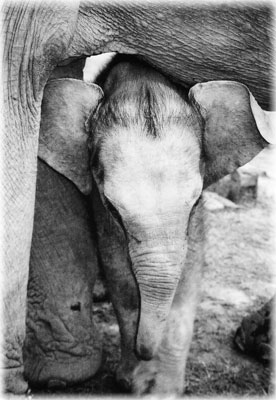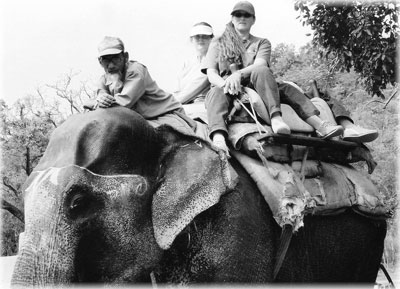Eight lions, 15 tigers, and a whole lot of elephants — an Indian wildlife safari
by Susan Tartaglino, Alvord, TX
India has so much to offer the traveler: palaces, forts, deserted cities, great cuisine, friendly people…. But did you know that it’s also a great wildlife destination? There’s a wonderful array of fauna, from the Asiatic lion to the Indian rhino, with over 1,200 species of birds plus landscapes ranging from arid desert to lush rainforest. You can even ride elephantback in search of the elusive Bengal tiger!
Gir Forest
My sister and I left Dallas for Mumbai on Jan. 30, 2005, for a 5-week custom tour of seven of India’s foremost wildlife parks. We’d planned our own itinerary and located a New Delhi-based travel agent, Prashanta Borgohain of Maharaja Voyages, Ltd. (fax +91 11 51642724 or visit www.travelagent-india.com), who made the arrangements for us at a price we could afford.
Our first stop was the little-visited Gir Forest in Gujarat. This dry, deciduous teak forest is full of spotted deer, sambar and nilgai, but the main attraction is the world’s last 300 Asiatic lions.
In the early morning hours of our first night at Gir, I heard a lion roaring close by. Val said I was dreaming, but the next night she heard it, too. We found out that there was a lion hospital right next door. A young male lion had been injured by another male and was recuperating there.
On our very first safari, we saw a big male. The next morning we had a superb view of two lions mating, and the following afternoon we saw three cubs whose two mothers were out hunting. Even on our few lionless outings we enjoyed the empty roads, the great views and the stunning variety of animals and birds (no tigers or elephants here, however).
We stayed at the Taj Group’s Gir Lodge ($150 double), which was aging but spacious and comfortable, and the service was excellent. As at most of the jungle lodges at which we stayed, the price included all meals. (Though called jungle lodges or resorts, none of the lodges was actually in the jungle. Generally, each was on the outskirts of a park and near or within a town.)
The pattern of safari outings at Gir was similar to the schedules at all of the parks, with minor variations. Getting up before dawn and grabbing a quick cup of tea, we were off to the entry gate before first light in an open Gypsy, India’s Jeep clone. We sometimes had a Gypsy to ourselves (especially at Gir), or we shared with two other travelers, plus a driver and guide.
Wildlife viewing continued until mid-morning, when we returned to the lodge for a late breakfast. Then there was time for resting or a bird-viewing walk until after lunch, when we departed for the afternoon safari around 3:00, returning at dusk.
These two daily outings encompassed the prime wildlife-viewing times, but it wasn’t always easy getting up in the dark, especially since it could be quite cold.
This was winter in India; days were warm to hot and nights, balmy to chilly. The high season is mid-October to March, with January and February being the most popular months. April, May and June are very hot, and from July through September most of the parks close for the annual monsoon.
Kanha
Next we flew to Nagpur in Madhya Pradesh, where we met the best driver in India, Mr. Joshi (arranged by Prashanta). Joshi would be with us for the next 23 days and five wildlife parks. His car was roomy, comfortable and spotlessly clean, his English was excellent and his sense of humor was always at the ready.
We were off on the 4-hour drive to Kanha. Traffic was very light for our next three long road trips, for we were on India’s lightly populated central plateau. However, road conditions here were mostly abysmal. At one point, going four miles an hour, we passed a bullock cart while a man on a bicycle was passing us. The scenery was lovely, however, as we drove through forests full of monkeys and tribal villages holding colorful markets.
We’d specified our lodging at Kanha, the famous Kipling Camp ($279 double), founded by Bob Wright who, with his wife, Anne, and daughter Belinda, was deeply involved in wildlife conservation in India for many years.
Kipling Camp is also home to Tara, the elephant featured in Mark Shand’s terrific book “Travels On My Elephant.” We spent two afternoons with Tara at the river, where we helped to bathe her and feed her goodies — the best hands-on elephant experience we have had anywhere.
A plus to staying at Kipling Camp is the English-speaking staff. At some of the other parks, the guides’ English was limited, making it hard to get information about the animals and birds beyond their names.
Kanha National Park is lush and green with huge meadows of long grass. A unique nature walk is offered in the large buffer zone, where we saw wild dogs and many birds.
Along with our next park, Bandhavgarh, Kanha is the best place to see tigers. In the pre-dawn hours, park mahouts rode their elephants on a tiger search, using their knowledge of tiger movements. If a tiger were found, its whereabouts were radioed to a central location. Visitors then queued up in their jeeps for their turn at tiger viewing by elephantback.
Three or four elephants took turns carrying participants between the road and the tiger. Used to elephants and accustomed to resting during the day, the tiger generally would stay put, even when the elephant was almost on top of it. Our first tiger decided to find a new spot and we followed him, crashing through the jungle on a wonderful tusker named Shivaji. We saw two more tigers at Kanha, one on a kill.
Of course, there’s always more wildlife to see, and it differs from one park to the next. Kanha was the first place where we saw a gaur (the world’s largest wild oxen) and the rare Barasingha deer, as well as jackals, sloth bears and much more.
Bandhavgarh
The worst road in India may be the direct route from Kanha to Bandhavgarh National Park, though it was interspersed with excellent sections (depending on the political clout of the local politician).
Seven of our 35 days in India were largely eaten up by road and air transfers. Trains are also available to some of the parks, but we preferred the luxury of our own car and driver. If you fly or take the train, the resort you’re staying in will provide transfers.
All of the safaris within the parks used Gypsies owned by the resort for transport. At Kanha, as elsewhere, Joshi stayed and ate at another resort along with other drivers, though he checked in with us daily in case we wanted to take excursions outside of the park, and he sometimes joined us on safari.
Bandhavgarh is a small park, its scenery more rugged than Kanha’s, and it seems to be dedicated to being India’s No. 1 park for seeing tigers. There were lots of tourists here — be ready to play bumper cars.
During our 5-day stay we saw seven tigers, including mating tigers and three cubs. Five of these viewings were from elephantback, the other two from our open vehicle. On our last evening safari we saw the park’s dominant male, B-2, who emerged from the jungle right beside our open vehicle, almost close enough to touch.
In addition to elephantback tiger viewing, elephant riding by the hour can be arranged. We had lots of fun on a young “trainee,” who spooked just like a nervous horse and showed us how fast an elephant can move!
Our lodge at Bandhavgarh, the Royal Tiger Resort ($190 double), consisted of luxury tents set in a lovely garden. We had an excellent driver-guide in the Royal Tiger’s manager, Anil Banyal.
Sights along the way
Since Khajuraho was on the way to our next park, we stayed there overnight. For our overnight stays between parks, we chose luxury hotels. Unlike the jungle lodges, these hotels did not include meals. At Khajuraho we stayed in the Taj Hotel Chandela ($110 double).
We toured the famous temple sculptures the next morning. Our local guide kept directing us to the erotic scenes while we were running around looking for the animal sculptures.
Then it was on to Agra and the Taj Mahal. We were now traveling on the densely populated plain of the Ganges. Roads were generally good, but traffic was heavy.
One thing we learned was that you do not want to drive yourself in India! It’s hair-raising enough to be a passenger, even with a great driver. The roads were full of a variety of transport, all going at different speeds — bullock carts, pedestrians, bicyclists, scooters, tuk-tuks, tractor-drawn wagons, water buffalo carts, camel carts, tongas, herds of sheep and goats, trucks, buses and other passenger cars — and in the middle of the mix are the ubiquitous cows. If one wants to lie down in the road for a snooze, it will do just that.
Keoladeo and Ranthambore
A short drive from Agra is one of the world’s great bird sanctuaries, Keoladeo National Park. Viewing can be done on foot, by rented bicycle or by bicycle-rickshaw.
However, this famous park is in trouble. Its waters have been diverted for local agriculture and its lakes have largely dried up. Groundwater was being pumped at a snail’s pace —_it was noisy, smelly and inadequate. Meanwhile, there were cows grazing on grass that was formerly underwater. Nevertheless, the birders we met were able to find 150 species in a single day, and we enjoyed our two trips into the park.
We stayed just outside the park entrance at the Ashok Bharatpur Forest Lodge ($95 double, meals not included). The attached restaurant had superb food.
Then it was on to Ranthambore, which became famous in the 1980s for its laid-back, easily viewed tigers. Because of this, and because it’s in the popular tourist state of Rajasthan, many, many tours of India include a stay here.
To accommodate as many visitors as possible, game viewing was by open trucks called canters, which seat 25 (but they squash in more — we had to stand once). Canters are dusty, bumpy and noisy, and the seats are far too small. There was little wildlife to be seen, no choice of routes and sometimes no guide.
We weren’t the only unhappy visitors here. A big tour group staying at our hotel mutinied after their first safari and refused to go on their second one.
We did see one tiger, sort of, at a distance and through heavy brush — a far cry from what we’d grown used to. We were able to improve our experience after a call to Prashanta and with the help of an excellent local guide, but our advice would be, if you have a choice, go somewhere else.
In fairness, the scenery was beautiful, the sparse vegetation makes for easy viewing, there’s a wonderful old fort and temple to visit, and we did meet a few people who were happy with their time there.
In all of the other parks, we’d chosen the best-available accommodation, which turned out to be clean and comfortable, each with a private bath, but very basic by American standards. Ranthambore was different. Luxury hotels were being built left and right, even though the only attraction there is the park, which already has far too many visitors.
Our hotel was the excellent Swai Madhopur Lodge ($220 double), the nicest of all of our jungle lodges.
Corbett Park
After Ranthambore, we continued to Jaipur for a city tour and overnight stay before heading to Delhi for a night at the grand Imperial ($300 double). We then traveled north to Jim Corbett National Park in the foothills of the Himalayas. Here is the lush jungle many people envision when they think of India. There were many tourists, but the park is big enough to accommodate them all, with several rest-house complexes within the park and elephantback safaris available at four different locations. At last we were able to ride elephants as much as we wanted.
Along with our first wild elephants, we saw three tigers from elephantback and one from the road. Our driver, Mohan, spotted this huge, muscular male by the river and we watched as it crossed the road right in front of us and disappeared into the jungle, accompanied by much roaring. “Mohan’s tiger” was our last of 15.
Kaziranga Park
Back in Delhi, we said good-bye to Joshi and flew northeast to Assam, one of India’s least-visited states. This is a beautiful area reminiscent of Southeast Asia, and Kaziranga National Park is famous for the rare Indian one-horned rhino. They are not rare in the park, though; we saw them on almost every safari.
In Assam we stayed at two different resorts, GL’s Resort, which caters only to Indian nationals, and the famous Wild Grass Lodge ($60 double). At GL’s Resort we discovered our favorite elephant, the massive makhna (tuskless male) Devi Lal, owned by the resort. He’d just been awarded top prize as the largest and most powerful elephant at the Kaziranga centenary, which included elephants and mahouts from all over Southeast Asia. Kaziranga concluded our stay in India.
Summing up
We prepaid most of our land costs to Prashanta ($4,511 each for the 35 days), which included all accommodations, most safari outings and all but a few meals. He also booked our five flights within India for a total of $1,012 per person.
We purchased our international air ourselves at $1,170 each on Northwest (Dallas-Mumbai-Dallas). Beyond this, we budgeted about $500 each for drinks, tips, laundry and souvenirs.
If you’re thinking of a visit, go soon. Large, well-managed parks like Kanha, Corbett and Kaziranga would appear to have a secure future, but others are under siege from population pressures, illegal cattle grazing and poaching.
If you’re interested in visiting mainly wildlife parks, you can work in many of the more traditional attractions en route, as we did. Or, if you opt for a tour, you can easily work in one or two parks.
The parks we visited were spread throughout the center and north of India. However, if you’re traveling to the south, consider Nagarhole, Bandipur, Mudumalai, Silent Valley, Periyar and Indira Gandhi national parks (recommended by the naturalist at Kipling Camp).
If you can visit only one or two parks, here’s our overall ratings of the ones we visited:
Five stars (highest): Corbett and Gir
Four stars: Bandhavgarh, Kanha and Kaziranga
Three stars: Keoladeo Bird Sanctuary
Two stars: Ranthambore
A stay of three nights in each park would be minimal; four or five nights would be better. Take good binoculars, neutral-colored clothing and a bird book. Winter weather is usually dry and warm, but take a sweater or jacket for early morning outings.
You should read up on the wildlife before you go. I recommend “Wildlife Reserves of India” by Sunjoy Monga, available at Amazon.com.


